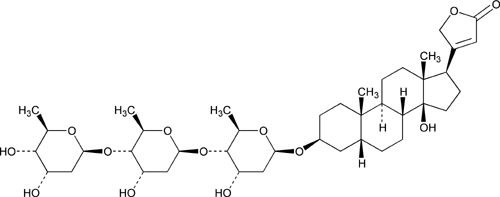Digitoxin
Card-20(22)-enolide, 3-[(O-2,6-dideoxy-
Digitoxin
» Digitoxin is a cardiotonic glycoside obtained from Digitalis purpurea Linné, Digitalis lanata Ehrhart (Fam. Scrophulariaceae), and other suitable species of Digitalis. Digitoxin contains not less than 92.0 percent and not more than 103.0 percent of C41H64O13, calculated on the dried basis.
Caution—Handle Digitoxin with exceptional care since it is highly potent.
Packaging and storage—
Preserve in tight containers.
Identification—
B:
Prepare a test solution in methanol containing 1 mg per mL. Apply 1 µL of the test solution and 1 µL of a Standard solution of USP Digitoxin RS in methanol containing 1 mg per mL to a suitable thin-layer chromatographic plate (see Chromatography  621
621 ) coated with a 0.25-mm layer of chromatographic silica gel mixture. Allow the applications to dry, and develop the chromatogram in a solvent system consisting of a mixture of methylene chloride and methanol (93:7) until the solvent front has moved about three-fourths of the length of the plate. Remove the plate from the developing chamber, mark the solvent front, and dry the plate at 100
) coated with a 0.25-mm layer of chromatographic silica gel mixture. Allow the applications to dry, and develop the chromatogram in a solvent system consisting of a mixture of methylene chloride and methanol (93:7) until the solvent front has moved about three-fourths of the length of the plate. Remove the plate from the developing chamber, mark the solvent front, and dry the plate at 100 to remove the solvent. Spray the plate with a 6 in 10 solution of sulfuric acid in methanol, heat at 105
to remove the solvent. Spray the plate with a 6 in 10 solution of sulfuric acid in methanol, heat at 105 for 10 minutes, and examine the chromatogram under long-wavelength UV light: the RF value of the principal spot obtained from the test solution corresponds to that obtained from the Standard solution.
for 10 minutes, and examine the chromatogram under long-wavelength UV light: the RF value of the principal spot obtained from the test solution corresponds to that obtained from the Standard solution.
C:
The retention time of the major peak in the chromatogram of the Assay preparation corresponds to that of the major peak in the chromatogram of the Standard preparation, as obtained in the Assay.
Loss on drying  731
731 —
Dry it in vacuum at 105
—
Dry it in vacuum at 105 for 1 hour: it loses not more than 1.5% of its weight.
for 1 hour: it loses not more than 1.5% of its weight.
Residue on ignition  281
281 :
negligible, from 100 mg.
:
negligible, from 100 mg.
Assay—
Mobile phase—
Prepare a filtered and degassed mixture of water and acetonitrile (55:45). Make adjustments if necessary (see System Suitability under Chromatography  621
621 ).
).
Standard preparation—
Dissolve an accurately weighed quantity of USP Digitoxin RS in Mobile phase, and dilute quantitatively, and stepwise if necessary, with Mobile phase to obtain a solution having a known concentration of about 40 µg per mL.
Assay preparation—
Transfer about 50 mg of Digitoxin, accurately weighed, to a 200-mL volumetric flask. Dissolve in and dilute with Mobile phase to volume, and mix. Pipet 4 mL of this solution into a 25-mL volumetric flask, dilute with Mobile phase to volume, and mix.
System suitability preparation—
Prepare a solution in Mobile phase containing about 40 µg each of digitoxin and digoxin per mL.
Chromatographic system
(see Chromatography  621
621 )—The liquid chromatograph is equipped with a 218-nm detector and a 3.9-mm × 30-cm column that contains packing L1. The flow rate is about 1 mL per minute. Chromatograph the Standard preparation and the System suitability preparation, and record the peak responses as directed for Procedure: the relative retention times are about 0.35 for digoxin and 1.0 for digitoxin; the resolution, R, between the digoxin and digitoxin peaks is not less than 2.0; the tailing factor for the analyte peak is not more than 2.0; and the relative standard deviation for replicate injections of the Standard preparation is not more than 2.0%.
)—The liquid chromatograph is equipped with a 218-nm detector and a 3.9-mm × 30-cm column that contains packing L1. The flow rate is about 1 mL per minute. Chromatograph the Standard preparation and the System suitability preparation, and record the peak responses as directed for Procedure: the relative retention times are about 0.35 for digoxin and 1.0 for digitoxin; the resolution, R, between the digoxin and digitoxin peaks is not less than 2.0; the tailing factor for the analyte peak is not more than 2.0; and the relative standard deviation for replicate injections of the Standard preparation is not more than 2.0%.
Procedure—
Separately inject equal volumes (about 50 µL) of the Standard preparation and the Assay preparation into the chromatograph, record the chromatograms, and measure the responses for the major peaks. Calculate the quantity, in mg, of C41H64O13 in the portion of Digitoxin taken by the formula:
1.25C(rU / rS)
in which C is the concentration, in µg per mL, of USP Digitoxin RS in the Standard preparation, and rU and rS are the peak responses obtained from the Assay preparation and the Standard preparation, respectively.
Auxiliary Information—
Please check for your question in the FAQs before contacting USP.
Chromatographic Column—
| Topic/Question | Contact | Expert Committee |
| Monograph | Maged H. Sharaf, Ph.D.
Senior Scientist 1-301-816-8318 |
(DSB05) Dietary Supplements - Botanicals |
| Reference Standards | Lili Wang, Technical Services Scientist 1-301-816-8129 RSTech@usp.org |
USP32–NF27 Page 2146
Chromatographic columns text is not derived from, and not part of, USP 32 or NF 27.
